Postia stiptica (Pers.) Jülich - Bitter Bracket
Phylum: Basidiomycota - Class: Agaricomycetes - Order: Polyporales - Family: Fomitopsidaceae
Distribution - Taxonomic History - Etymology - Identification - Culinary Notes - Reference Sources
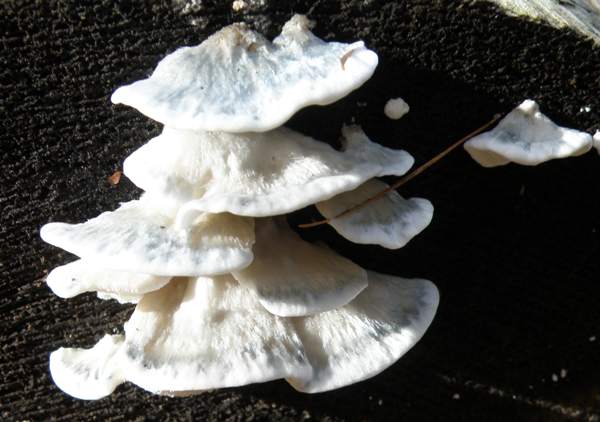
The Bitter Bracket is fairly common but often very well hidden, so that despite being big and brilliant white it is easily missed. More often than not the fruitbodies are quite small and attached to the sawn ends of felled tree trunks, where they form tiers (and tears, for these are weeping fungi).
The watery droplets that in all but the driest of weather exude from the margin and the pores on the fertile (lower) surface help distinguish this bracket from several other related pallid polypores.
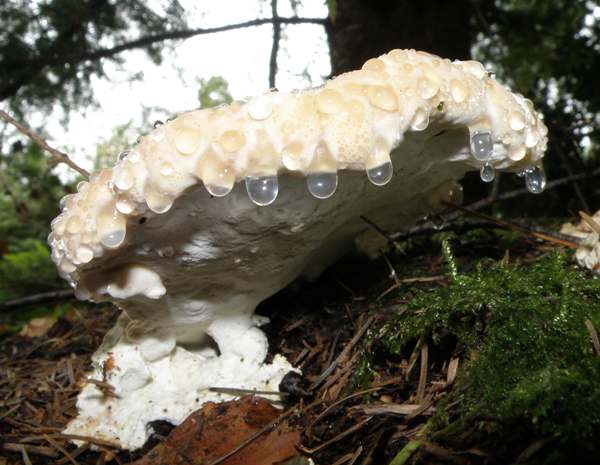
Distribution
Widespread and fairly common in Britain and Ireland, Postia stiptica is found throughout most of mainland Europe and is most common in central and northern Europe. The Bitter Bracket is also recorded in many parts of Asia, North America and Australia.
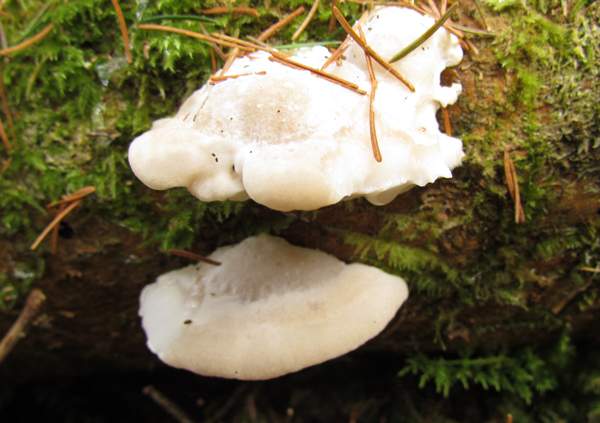
Taxonomic history
Although this fungus was described as early as 1774 by Jacob Christian Schaeffer, who called it Boletus albidus, it basionym (first valid specific epithet) dates from 1801, when Christiaan Hendrik Persoon described it and gave it the scientific binomial name Boletus stipticus. Swiss mycologist Walter Jülich transferred this species to its present genus, thereby establishing its currently accepted name as Postia stiptica.
Synonyms of Postia stiptica include Boletus albidus Schaeff., Boletus stipticus Pers., Polyporus stipticus (Pers.) Fr., Polyporus albidus (Schaeff.) Trog, Leptoporus stipticus (Pers.) Quél., Polystictus albidus (Schaeff.) Cooke, Leptoporus albidus (Schaeff.) Bourdot & Galzin, Bjerkandera colliculosa P. Karst., Tyromyces stipticus (Pers.) Kotl. & Pouzar, and Oligoporus stipticus (Pers.) Gilb. & Ryvarden.
Etymology
Postia, the genus name, was established by Elias Magnus Fries in honour of the Swedish naturalist Hampus von Post (1822 - 1911). The specific epithet stiptica is a reference to the stiptic (staunching) characteristic of this bracket fungus, which is purported to stop the bleeding if it is applied to an open wound.
Identification Guide
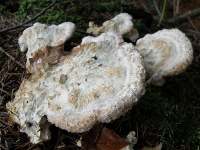 |
CapIrregular bracket; up to 10cm across; sometimes roughly semicircular but more often shell shaped and very occasionally in the form of a lopsided spinning top; 1 to 3cm thick; upper (infertile) surface finely velvety, uneven; white, becoming light ochre with age; margins rounded in young specimens, more acute as fruitbodies age; lower (fertile) surface with tubes and pores; watery droplets are exuded mainly from margin region and from the pores. The specimen on the left is old and is turning ochre-brown. |
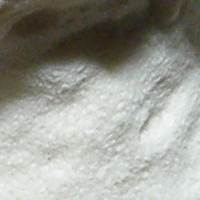 |
TubesThe tubes are white and 2 to 6mm deep. PoresThe tiny pores are also white and spaced at 3 to 4 per mm. |
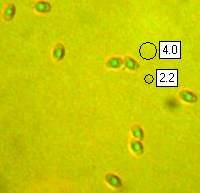 |
SporesElongated ellipsoidal to cylindrical, smooth, 3.5-4.5 x 2-2.5µm; inamyloid. Spore printWhite. |
Odour/taste |
Strong fungal odour; very bitter taste. |
Habitat & Ecological role |
Usually on felled trunks and large fallen branches of conifers; very occasionally on the timber of hardwood trees. |
Season |
Throughout the year, but releasing spores in late autumn. |
Similar species |
Postia caesia is similar but has a blue tinge and lacks the watery droplets associated with the Bitter Bracket. |
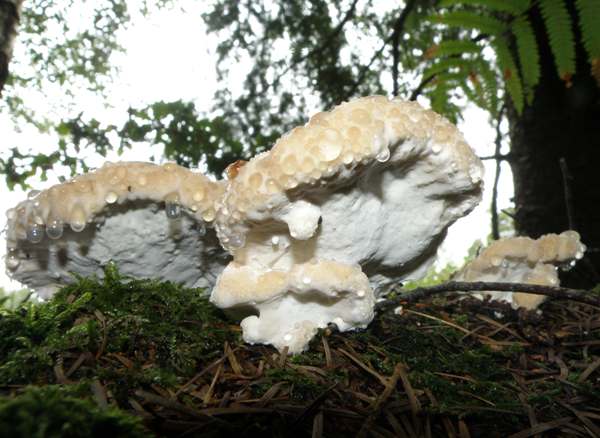
Culinary Notes
These bracket fungi are far too bitter tasting to be considered edible.
Reference Sources
Mattheck, C., and Weber, K. Manual of Wood Decays in Trees. Arboricultural Association 2003.
Fascinated by Fungi, 2nd Edition, Pat O'Reilly 2016, reprinted by Coch-y-bonddu Books in 2022.
BMS List of English Names for Fungi
Dictionary of the Fungi; Paul M. Kirk, Paul F. Cannon, David W. Minter and J. A. Stalpers; CABI, 2008
Taxonomic history and synonym information on these pages is drawn from many sources but in particular from the British Mycological Society's GB Checklist of Fungi.
Acknowledgements
This page includes pictures kindly contributed by David Kelly.
Fascinated by Fungi. Back by popular demand, Pat O'Reilly's best-selling 450-page hardback book is available now. The latest second edition was republished with a sparkling new cover design in September 2022 by Coch-y-Bonddu Books. Full details and copies are available from the publisher's online bookshop...

